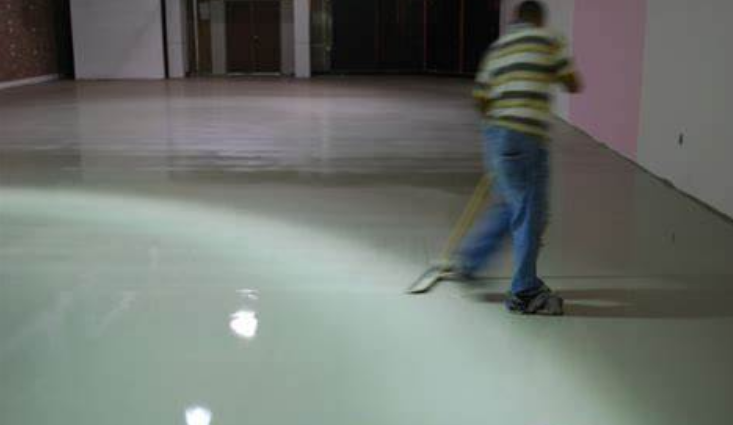Floor subfloor
Concrete subfloors must be cured for 28 days, cement-sand and polymer-cement screeds must be cured until they are firm and dry to a residual moisture content not exceeding 4 wt% (see manufacturer's instructions). The surfaces to be coated must comply with
SNiP 2.03.13-88. This means that the surface of the substrate must be dry, firm, rough, free of lime (cement), dust, grease and other substances that reduce adhesion. Tensile strength of the prepared concrete base must be at least 1.5 N/mm2 (1.5 MPa). The compressive strength of the substrate must be at least 20 MPa (M 200).
The moisture content of the concrete substrate must not exceed 4 wt.%. Prior to coating concrete bases, the moisture content of the substrate must be checked by means of, for example, special devices or, at the very least, an approximate estimate by taping an undamaged piece of polyethylene (size 1x1 m) around the perimeter of the substrate. Check the humidity after about 3 days. The absence of moisture droplets on the inner surface of the polyethylene and a dark (damp) stain on the surface of the substrate indicates normal substrate humidity. When applying self-leveling
flooring on a damp substrate, bubbles form on the surface and the adhesion to the substrate decreases.
Tanks, insufficient quantity and volume
It is necessary to prepare in advance a sufficient number of clean, dry containers of sufficient volume (a standard package of 36 kg requires at least two containers with a minimum capacity of 30 l) for the work to be done. Insufficient mixing containers and inadequate (small) volumes will ultimately lead to mixing errors (such as local "non-mixing", incorrect mixing ratios, etc.) and to unnecessary time required for complete mixing. Mixing errors lead to hard to remove defects in the coating, such as local non-curing of the material, prolonged curing of the material, blistering and bubbling of individual areas. Stirring time losses, because the lifetime of the prepared composition is limited (approximately 60 minutes at 20 °C), lead to errors in material placement, especially at high ambient temperatures, expressed in uneven material placement, the presence of air bubbles in the coating, as there is no time for rolling with a needle roller de-aerating.

Stirring nozzle of unsatisfactory quality
As practice shows, the most consistent results are obtained with the use of the commonly used conventional screw-type mixing nozzle for drills. The use of different types of "advanced" mixing heads will most often result in unsatisfactory mixing and consequently in a serious defect, local "non-mixing". Mixing nozzles should be of such lengths that they can thoroughly mix the entire depth of the material, and most importantly, at the bottom of the mixing tank. Do not use homemade nozzles.
Drill. Low power
An electric drill with a power output of approx. 1 kW, but no less than 800 W should be used, especially in low ambient temperatures (the viscosity of the material is higher at low temperatures). If the power of the drill is insufficient, there is a high risk that the tool will malfunction during the paving operation due to overloading, which may lead (if no spare tool is available) to a loss of material in the mixing vessel and the formation of a seam in the pavement. There is a fairly high risk that a low-powered drill will not allow good mixing.
Racker
The main working tool of the paver is usually the doctor, a tool with an adjustable gap; another variant of this tool is a spatula with a rubber toothed nozzle. The main property of a scraper is its ability to distribute the material over the substrate in a layer of the desired thickness, so it is important that the scraper is accurate in setting and maintaining the gap between the scraper edge and the substrate. The blade should be rigid and not vibrate during operation, which is especially important when working in high ambient temperatures. A wide doctor blade increases productivity, but it is difficult to work close to the abutments. It is also difficult to work with a wide spreader if the subfloor does not fully meet the subfloor requirements for the floor finish. The floor base shall meet the requirements of SNiP 2.0.13-88.
Floors hallway.
Dirty shoes
When working on the arrangement of the filler flooring is required to observe the regime of cleanliness. On the primed surface should go in a clean, preferably a change of shoes. It is unacceptable to enter the surface prepared for priming with dirty shoes. Before entering the pouring area, you must arrange a place to change shoes by covering several square metres of the surface with polyethylene film. If these simple requirements are not met, problems with particles of foreign matter in the material - are assured. Pieces of dirt covered with a layer of the material form bumps and protrusions on the surface of the finished floor, reducing the decorative appearance of the floor, and leading to discomfort during wet cleaning of the room. The process of manually removing the agglomerates of dirt from the fresh material layer at the time of the job is labour intensive, especially if there are large quantities of them.
Hoover
An
industrial hoover must be used to dedust the surface before work commences. Replacing the hoover with a thorough sweeping is possible in principle, but in practice often leads to insufficient dusting and contamination of the surface with pieces of the brushes and brooms.
Comments
Post a Comment